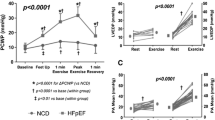Abstract
In this review, we make a comprehensive summary of exercise stress echocardiography in hypertrophic cardiomyopathy (HCM) and practical tips used in our hospital. The main objective of performing exercise stress echocardiography in patients with HCM is to evaluate left ventricular outflow tract obstruction, mitral regurgitation, left ventricular asynergy, and diastolic function during exercise. There are limitations to the explanations that can be provided for exertional symptoms when resting echocardiography is performed in patients with HCM. In contrast, exercise stress echocardiography causes the manifestation of findings that are latent at rest, which possibly provides the elucidation of symptom etiology. In this article, we focus on the usefulness of exercise stress echocardiography in HCM.





Similar content being viewed by others
References
Elliott PM, Anastasakis A, Authors/Task Force members, et al. ESC Guidelines on diagnosis and management of hypertrophic cardiomyopathy: the Task Force for the Diagnosis and Management of Hypertrophic Cardiomyopathy of the European Society of Cardiology (ESC). Eur Heart J. 2014;2014(35):2733–79.
Otto CM. Textbook of clinical echocardiography. 5th ed. Philadelphia: Elsevier; 2013. p. 234.
Otto CM. Practice of clinical echocardiography. 4th ed. Philadelphia: Elsevier; 2012. p. 281.
Owens DS, Otto CM. Exercise testing for structural heart disease. In: Gillam L, Otto CM, editors. Advanced approaches in echocardiography. Philadelphia: Saunders; 2012.
Petkow Dimitrow P, Cotrim C, Cheng TO. Need for a standardized protocol for stress echocardiography in provoking subaortic and valvular gradient in various cardiac conditions. Cardiovasc Ultrasound. 2014;12:26.
Drinko JK, Nash PJ, Lever HM, et al. Safety of stress testing in patients with hypertrophic cardiomyopathy. Am J Cardiol. 2004;93:1443–4.
Maron MS, Olivotto I, Zenovich AG, et al. Hypertrophic cardiomyopathy is predominantly a disease of left ventricular outflow tract obstruction. Circulation. 2006;114:2232–9.
Shah JS, Esteban MT, Thaman R, et al. Prevalence of exercise-induced left ventricular outflow tract obstruction in symptomatic patients with non-obstructive hypertrophic cardiomyopathy. Heart. 2008;94:1288–94.
Nakatani S, Marwick TH, Lever HM, et al. Resting echocardiographic features of latent left ventricular outflow obstruction in hypertrophic cardiomyopathy. Am J Cardiol. 1996;78:662–7.
Lafitte S, Reant P, Touche C, et al. Paradoxical response to exercise in asymptomatic hypertrophic cardiomyopathy: a new description of outflow tract obstruction dynamics. J Am Coll Cardiol. 2013;62:842–50.
Peteiro J, Montserrat L, Castro-Beiras A. Labil subaortic obstruction during exercise stress echocardiography. Am J Cardiol. 1999;84:1119–23.
Ryan K, Murphy RT, DiPaola LM, et al. Mitral valve abnormalities in hypertrophic cardiomyopathy: echocardiographic features and surgical outcomes. Ann Thorac Surg. 2008;85:1527–35.
Fighali S, Krajcer Z, Edelman S, et al. Progression of hypertrophic cardiomyopathy into a hypokinetic left ventricle: higher incidence in patients with midventricular obstruction. J Am Coll Cardiol. 1987;9:288–94.
Peteiro J, Bouzas-Mosquera A, Fernandez X, et al. Prognostic value of exercise echocardiography in patients with hypertrophic cardiomyopathy. J Am Soc Echocardiogr. 2012;25:182–9.
Reant P, Reynaud A, Pillois X, et al. Comparison of resting and exercise echocardiographic parameters as indicators of outcomes in hypertrophic cardiomyopathy. J Am Soc Echocardiogr. 2015;28:194–203.
Sherrrid MV, Mahenthiran J, Casteneda V, et al. Comparison of diastolic septal perforator flow velocities in hypertrophic cardiomyopathy versus hypertensive left ventricular hypertrophy. Am J Cardiol. 2006;97(1):106–12.
Mizukoshi K, Suzuki K, Yoneyama K, et al. Early diastolic function during exertion influences exercise intolerance in patients with hypertrophic cardiomyopathy. J Echocardiogr. 2013;11:9–17.
Author information
Authors and Affiliations
Corresponding author
Rights and permissions
About this article
Cite this article
Suzuki, K., Akashi, Y.J. Exercise stress echocardiography in hypertrophic cardiomyopathy. J Echocardiogr 15, 110–117 (2017). https://doi.org/10.1007/s12574-017-0338-4
Received:
Revised:
Accepted:
Published:
Issue Date:
DOI: https://doi.org/10.1007/s12574-017-0338-4




